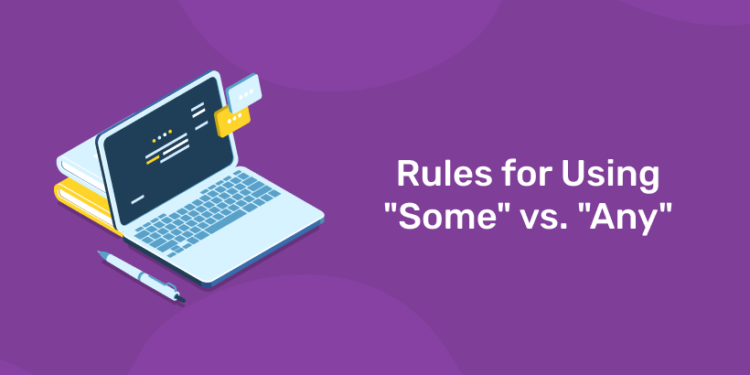Table of Contents
Introduction
Imagine sending a message to a friend about snacks at a party, and they show up with nothing because your words confused them. Small words like “some” and “any” can change the whole meaning of what you say. People often mix them up, leading to unclear talks or awkward moments. This post dives into the rules for using “some” vs. “any” to help you speak and write with confidence. Clear language builds strong bonds and avoids mix-ups in daily life. By the end, you will grasp when to pick one over the other, making your words sharp and effective. Stick around to see real examples that show the difference in action.
English has many tricky parts, but these two words stand out for their subtle shifts in tone. “Some” suggests a positive amount, while “any” leans toward questions or negatives. Learning their rules boosts your skills in emails, chats, or reports. Think about how pros in sales or teaching rely on exact words to get points across. You can do the same. This guide breaks it down step by step, with tips to lock in the knowledge. Get ready to transform fuzzy sentences into clear ones that grab attention.
Understanding the Meaning of “Some” and “Any”
1: Which of the sentences below is grammatically correct?
“Some” points to an amount that exists but stays vague. It fits in positive statements where you expect something to be there. For example, if you say, “I have some apples in the fridge,” it means a few apples sit ready to eat. This word carries a sense of plenty or at least enough to mention. It invites agreement and keeps things light.
On the flip side, “any” deals with amounts in questions, negatives, or choices without limits. It opens doors to possibilities but often hints at doubt or lack. Take the sentence, “Do you have any plans for tonight?” Here, it asks if even one plan exists, without assuming yes or no. In negatives, like “I don’t have any money left,” it stresses zero amount. “Any” works well when options feel open or when you want to cover all bases.
Both words handle countable and uncountable nouns, but context shapes their fit. Countable nouns, such as books or cars, pair with them for groups. Uncountable ones, like water or advice, use them for portions. The key lies in the sentence type: affirmative for “some,” interrogative or negative for “any.” Mix them wrong, and your message might twist.
Picture a job interview where you say, “I have some experience in that field.” It sounds sure and ready. Switch to “any,” and it becomes a question, which might not fit. Or in a store, “Is there any milk?” checks for presence without hope built in. “Some” would odd out there unless you affirm it. These shades make English rich but demand care.
To build skill, spot them in books or talks. Notice how speakers use “some” to share facts and “any” to probe or deny. This habit sharpens your ear. Over time, you pick the right one without pause. Strong grasp here leads to better stories, arguments, or instructions. People trust clear speakers more.
Spoken English Course for Guaranteed Confidence and Career Growth
Spoken English Course by Entri App: Enhance your communication skills, gain certification, and boost your career with confidence.
Join Now!Rules for Using “Some” in Sentences
Use “some” in positive sentences to show an indefinite but real amount. It works with both countable and uncountable nouns. For instance, “She bought some flowers for the table” implies a handful, enough to matter. This rule keeps statements upbeat and factual.
In offers or requests that expect a yes, “some” shines. Say, “Would you like some coffee?” It assumes the person might accept, making the invite warm. Without it, the tone cools. Pair it with plurals or mass nouns for smooth flow.
“Some” also fits in statements about parts of a group. “Some students passed the test” means not all, but a portion did. This adds nuance without numbers. It helps in reports or summaries where exact counts hide.
For uncountable items, “some” suggests a bit present. “Add some salt to the soup” directs action with assurance. It avoids the empty feel of other words. Practice this in cooking or shopping lists to see gains.
In comparisons or general truths, “some” broadens scope. “Some people prefer tea over coffee” covers a slice of folks without claiming most. This rule aids in essays or debates, where balance counts.
Exceptions pop up in questions that lean positive. “Can I have some water?” expects availability. It differs from neutral checks. Use it when context hints at yes.
To lock in, rewrite sentences without “some” and note the shift. “I need sugar” versus “I need some sugar.” The first demands, the second requests softly. This tweak polishes polite talk.
Expand with compounds like “someone,” “somewhere,” “something.” They follow similar paths. “Someone called you” affirms a call happened. Link them back to base rules for consistency.
In stories, “some” builds scenes. “He found some old coins in the yard” sparks interest without details. It pulls readers in, urging them to picture more.
Daily use cements these rules. In emails, “I have some ideas for the project” opens doors. It shows readiness. Over weeks, this becomes second nature, lifting your word game.
Count examples: “Some dogs bark at night.” Positive, indefinite. “She ate some cake.” Uncountable, affirmative. “Some friends came over.” Group part. Pile them up to master.
In teaching kids, start simple. “There are some toys in the box.” They learn fast with visuals. Adults benefit too from such basics.
For non-native speakers, pair with audio. Hear “some” in songs or shows. It sticks better than books alone.
Build paragraphs around it. Describe a picnic: “Pack some sandwiches, some fruit, and some drinks.” Flow feels natural.
In business notes, “We need some changes to the plan.” It softens orders. Clients respond well.
Travel tales: “I saw some amazing sights in the city.” Invites questions.
Health tips: “Eat some vegetables every day.” Encourages without force.
These rules, with practice, make “some” your ally in clear speech.
Rules for Using “Any” in Sentences
“Any” works across questions, negatives, and conditionals to show openness, absence, or broad possibility. In questions, it keeps the inquiry neutral, as in “Do you have any questions?” which allows for none or many. In negative sentences, it emphasizes the lack of something, like “He doesn’t have any siblings.” It fits naturally with “not,” “no,” “hardly,” “barely,” and “without,” as in “She left without any warning.” In conditional sentences, “any” covers all possible situations, such as “If you need any help, call me.” It also shows freedom of choice, seen in “Pick any color you like.”
The same rule applies to both uncountable and countable nouns: “Is there any water left?” and “Are there any books on the shelf?” Affirmative exceptions exist when “any” means “no matter which,” as in “Any dog can learn tricks.” Compounds like “anyone,” “anywhere,” and “anything” carry the same open meaning: “Anyone can join.” It’s also common in warnings, as in “Don’t touch any buttons.” You can practice by flipping positive statements into negatives, such as changing “I have some time” to “I don’t have any time.” In debates, it asks for evidence (“Is there any proof?”), and in storytelling, it builds suspense (“She didn’t find any clues”). It appears in emails (“Let me know if you have any issues”), shopping questions (“Do you sell any organic fruit?”), health advice (“Avoid any fatty foods”), and travel queries (“Can I go any faster?”). It also works with time (“It could rain at any moment”) and planning (“We can meet any day next week”).
Children naturally use it (“Is there any candy left?”), and learners benefit from repeating structures that show how “any” signals uncertainty or possibility. It shows up in general descriptions too, such as “Without any tools, he fixed the car. Anyone would admire that. At any rate, it worked.” In business contexts, it keeps instructions precise: “Report any errors right away.” All these patterns help you use “any” accurately and clearly.
Common Mistakes and How to Avoid Them
The more the learner doesn’t check the word type, the two are “some” and “any.” In negatives, neither is the right one – both are positive. If any are used, in a traditional affirmative “I have any friends coming over” and in neutral questions “have you some ideas?”, it sounds old. When you ask an offer or request, some sounds warmer — “would you like some tea?” — all questions generally take both.
Context also guides compounds such as somebody, somebody, someone, and any. Some positive statements are somewhat mixed – questions and negatives are all mixed . This can be done through speaking aloud, proofreading and using writing aids. Practice also helps you to write ‘some apples’ or ‘any apples’ for statements or “any apples?” for questions. The best way to identify these patterns is in reading books, conversations and everyday communication.
Meaning connections to use simplify the choices. Some suggest it exists; others suggest uncertainty. That applies to emails, stories, instructions and everyday advice, “Take some medicine” and “Don’t take any risks.” Remarking on drafts, following patterns, and testing yourself with quizzes are all ways to avoid common errors and maintain consistent accuracy.
Spoken English Course for Guaranteed Confidence and Career Growth
Spoken English Course by Entri App: Enhance your communication skills, gain certification, and boost your career with confidence.
Join Now!Conclusion
Mastering “some” vs. “any” clears up daily talks and writing. These rules guide choices for impact from questions to statements; right picks build trust. Practice turns theory into a habit. Clear words open doors in work and play. Keep using them right, and watch bonds grow. Your voice stands out when precise. End with this: Small changes yield big gains in how people hear you.
Spoken English Course for Guaranteed Confidence and Career Growth
Spoken English Course by Entri App: Enhance your communication skills, gain certification, and boost your career with confidence.
Join Now!Frequently Asked Questions
I get the basic rule that "some" is for positives and "any" for questions and negatives. But why does my English friend sometimes say, "Would you like some tea?" Isn't that a question?
This is an excellent observation that highlights a crucial nuance in English. You are correct that “any” is standard in most questions. However, the rule shifts based on the expectation or intention behind the question.
-
Questions with “Any” (Neutral/Open-Ended): These are genuine, information-seeking questions where you have no assumption about the answer. For example, “Do you have any questions?” You don’t know if the person has questions or not; the answer could be “yes” or “no.”
-
Questions with “Some” (Offers/Requests expecting a “Yes”): These are not neutral questions; they are polite offers, invitations, or requests where you anticipate or hope for a positive response.
-
Offer: “Would you like some cake?” (I have cake, and I expect you might want some.)
-
Request: “Can I have some water?” (I see the water and believe it’s available; I’m politely asking for it.)
-
Think of it as a social cue. Using “some” in these contexts makes the offer sound more generous and the request more confident and polite. Using “any” (“Would you like any cake?”) isn’t grammatically wrong, but it can sound more distant, hesitant, or as if you’re doubtful the cake exists.
The article mentions "any" can be used in positive sentences to mean "no matter which." Can you give more examples and explain how this is different from "some"?
Absolutely. This is a powerful and common exception where “any” takes on a universal or inclusive meaning in affirmative statements. It emphasizes that it doesn’t matter which one you choose from a group; all are possible or acceptable.
-
“Any” for “No Matter Which”:
-
“You can choose any seat you like.” (All seats are available for choosing.)
-
“Any competent mechanic can fix this.” (It doesn’t matter which mechanic, as long as they are competent.)
-
“She can solve any problem we give her.” (Her ability applies to all problems.)
-
-
Contrast with “Some”:
-
“You can choose some seats you like.” (This implies you can choose a limited number of seats, but not all of them. The meaning shifts from freedom to partial selection.)
-
“Some competent mechanics can fix this.” (This means only a portion of competent mechanics can do it, not all.)
-
The key difference is scope. “Any” in this sense means every single one in a category, while “some” always refers to an indefinite but limited part of a category.
How do the compound words like "someone," "anywhere," "anything," and "somebody" follow the same rules?
The compounds follow the core rules of their root words perfectly. This provides a reliable framework for using them correctly.
-
“Some-” Compounds in Positive Statements & Expectant Requests:
-
“Someone left their umbrella.” (Affirmative statement.)
-
“I’m going somewhere quiet this weekend.” (Affirmative statement.)
-
“Would you like something to drink?” (Polite offer expecting a ‘yes’.)
-
-
“Any-” Compounds in Questions, Negatives, and for “No Matter Which”:
-
“I didn’t see anyone at the park.” (Negative sentence.)
-
“Is there anything I can do to help?” (Neutral question.)
-
“We can’t find the keys anywhere.” (Negative sentence.)
-
“Anyone can learn to play the guitar.” (This means “no matter who,” it is possible for all people.)
-
Memorizing the core rule for “some” and “any” automatically gives you the key to correctly using all of their compound forms.
4. FAQ: In negative sentences, when should I use “any” versus “no”? For example, what’s the difference between “I don’t have any money” and “I have no money”?
Answer: Both sentences are grammatically correct and convey the same essential meaning: a zero amount. However, the difference lies in tone, emphasis, and formality.
-
Using “not… any”: This is the more common and neutral way to form a negative in everyday, conversational English. “I don’t have any money” sounds like a standard, factual statement.
-
Using “no”: Using “no” directly with the noun is often more emphatic and can sound slightly more formal or absolute.
-
“I have no idea!” (This can sound stronger than “I don’t have any idea.”)
-
“There is no time to waste.” (This sounds more urgent and definitive.)
-
In most daily situations, “not… any” is your safe and natural choice. Using “no” can add a punch of emphasis, but overusing it might make your speech sound a bit blunt or dramatic.
Can "some" and "any" be used with both singular and plural nouns? I'm confused about "Is there any problem?" vs. "Are there any problems?"
This is a subtle but important point related to countable and uncountable nouns.
-
With Uncountable Nouns: Both “some” and “any” are used with singular verb forms because the noun is treated as a singular mass.
-
“There is some water on the floor.”
-
“There isn’t any water left.”
-
-
With Countable Nouns: This is where your examples fit.
-
Plural Countable Nouns: This is the most common structure. “Are there any problems?” (Using the plural “problems” with a plural verb “are” is standard.)
-
Singular Countable Nouns: Using “any” with a singular countable noun shifts the meaning slightly. “Is there any problem?” often implies “Is there a single, specific problem we should discuss?” or can even carry a defensive or confrontational tone, like “Do you have a problem with me?”. In most cases of general inquiry, the plural form (“any problems”) is safer and more natural.
-
Are there any official "exceptions" for using "some" in questions beyond offers and requests?
While offers and requests are the primary exceptions, there’s another context where “some” appears in questions: when we suspect or already know the answer is “yes.”
Imagine you hear a noise in the kitchen. You might ask your roommate, “Did you buy some groceries?” You use “some” because you can probably see the bags or you had discussed it earlier, so you have a reason to believe the answer is affirmative. Conversely, if you have no idea, you would ask, “Did you buy any groceries?”
This use is less about politeness and more about reflecting a pre-existing assumption or evidence.
How can I practice this effectively to make it a natural habit? Are there specific exercises you recommend?
Moving from theory to habit requires consistent, mindful practice. Here are a few expert-recommended exercises:
-
The Transformation Drill: Take a positive sentence and transform it into a negative and a question.
-
Positive: I need some help.
-
Negative: I don’t need any help.
-
Question: Do you need any help?
-
-
The Audio Immersion Method: Actively listen for “some” and “any” in English movies, podcasts, and conversations. Don’t just hear them; pause and ask why the speaker chose that word. Was it an offer? A negative? A universal statement?
-
The Writing Sprint: Write a short story or paragraph about your day, deliberately forcing yourself to use both “some” and “any” (and their compounds) at least five times each. Contextualizing them in your own narrative builds deeper memory.
-
Self-Recording: Record yourself answering questions like “What’s in your fridge?” (I have some…) and “What don’t you have?” (I don’t have any…). Listening back helps you self-correct.
What is the biggest, most common mistake learners make with these words, and how can I ensure I avoid it?
The single most common mistake is defaulting to “any” for all questions, ignoring the important nuance of polite offers and requests.
-
Incorrect Default: “Would you like any coffee?”
-
Correct Nuance: “Would you like some coffee?”
How to avoid it: Create a mental checklist. Before you speak, ask yourself: “Is this a genuine information question, or am I making an offer or a request?”
-
Information Question -> Use “Any”: “Do you have any siblings?”
-
Offer/Request -> Use “Some”: “Can I offer you some advice?”
Making this two-second mental switch will dramatically improve your naturalness and politeness in spoken English.
Do these rules for "some" and "any" apply exactly the same way in American English and British English?
For the vast majority of cases, the rules for “some” and “any” are consistent across all major dialects of English, including American, British, Australian, and Canadian. The core principles of positives/offers vs. questions/negatives are universal.
Any differences would be extremely minor and related to regional colloquialisms or slang, not the fundamental grammatical rules outlined in the article. You can confidently apply these rules anywhere in the English-speaking world.
How does mastering these small words actually impact how native speakers perceive my fluency and confidence?
The impact is profound. While a listener will understand you if you mix them up, correct usage operates on a subconscious level to build a positive impression.
-
Fluency: Using “some” and “any” correctly makes your speech flow more naturally. You avoid the slight awkwardness of sentences like “Would you like any wine?” and instead produce the more idiomatic “Would you like some wine?” This smoothness is a hallmark of advanced fluency.
-
Confidence: Correctly navigating these subtleties shows a deep understanding of English pragmatics (how language is used in social contexts). It demonstrates that you’re not just translating words, but you’re understanding intent and nuance. This projects confidence and linguistic competence.
-
Politeness and Rapport: As we’ve seen, choosing “some” in an offer makes you sound more generous and engaged. This subtle social signaling helps build stronger bonds and prevents you from accidentally sounding distant or uncertain.
In essence, mastering “some” and “any” is not about avoiding a glaring error; it’s about fine-tuning your language to sound more natural, polite, and proficient—qualities that make people more likely to engage with you in meaningful conversation.
In negative sentences, when should I use "any" versus "no"? For example, what's the difference between "I don't have any money" and "I have no money"?
Both sentences are grammatically correct and convey the same essential meaning: a zero amount. However, the difference lies in tone, emphasis, and formality.
-
Using “not… any”: This is the more common and neutral way to form a negative in everyday, conversational English. “I don’t have any money” sounds like a standard, factual statement.
-
Using “no”: Using “no” directly with the noun is often more emphatic and can sound slightly more formal or absolute.
-
“I have no idea!” (This can sound stronger than “I don’t have any idea.”)
-
“There is no time to waste.” (This sounds more urgent and definitive.)
-
In most daily situations, “not… any” is your safe and natural choice. Using “no” can add a punch of emphasis, but overusing it might make your speech sound a bit blunt or dramatic.











